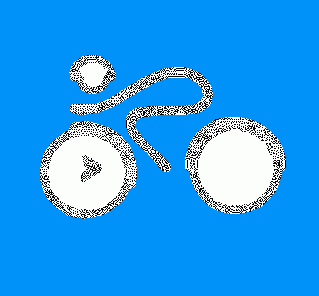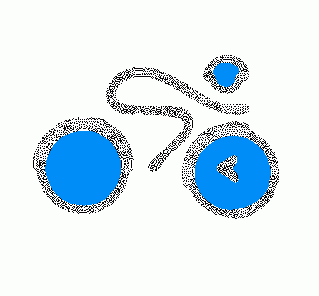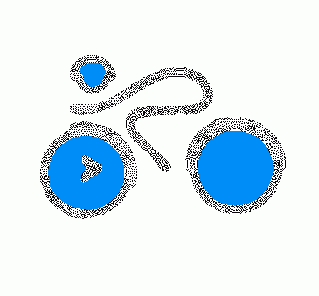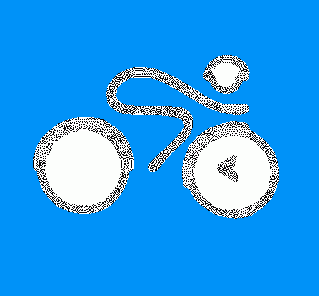| Newsletter - 2006 Archive |

|

|
Cycling Club |

|

|
| Newsletter - 2006 Archive |

|

|
Cycling Club |

|

|
Next--->
|
Alberta Golden
Triangle+ 400 km Brevet (May
27/06) This 400 km brevet was one in the Alberta Mountain series organized by Ken Myhre of the Calgary Chapter of the Alberta Randonneurs. There is something very special about mountain brevets, I find. First, there is the rockscape, the ever changing skies, the surprising elements, the challenging ascents and the rewarding descents. If it is difficult to wrap one's head around doing brevets in general, mountain rides have that special dimension. There is that sense of adventure and curiosity. What lies behind the next bend in the road, over the next hill, beyond the next mountain pass. As we find ourselves at the foot of a very long climb, there is also a sense of humility, a perspective we get when comparing ourselves with the eternity and size of the giant peaks. Yet, we also have this urge to be in charge, as we dig deep into ourselves and subsequently reach the summit of a mountain pass. Can I do it -- yes I can -- I did. That sense of immense satisfaction. Of course, it's a lot easier to write this from the seat of a chair than to do on the seat of a bicycle. So here I found myself driving on May 26/06 from Fort St. John to Banff (about 900 km), rain coming down for most of the drive. In Grand Cache (Alta) I checked the forecast for both Banff and Kamloops; the latter also had a 400 km brevet, which I considered at the last minute in case Banff would be a horror show. Despite a lousier forecast, I selected Banff over Kamloops. During the drive I encountered snow showers at the Athabasca Glacier and the Bow Pass. I had booked a room for two nights at the Y in Banff, which @ $27.00 per night royally beat the Fairmont Hot Springs Hotel. The forecast did not look that good. In fact, it worsened when I got to Banff: 10-15 mm rain; snow overnight and for the next night. I started to regret that I hadn't gone to Kamloops. That regret lingered until I saw the conditions during their 400 km brevet: nothing but headwinds. At the Y in Banff I met up with Ken, who also had booked a bed there. At 4:00 am the alarm went off; we had a quick breakfast, and I decided to check the weather again. The skies looked gloomy. The 5:00 am forecast was not out yet, but I scanned Environment Canada's satellite imagery. It showed a bit of an opening in the cloud cover west of the mountains in the Columbia valley. There was that glimmer of hope I was looking for, offsetting the 2 0C temperature and morning drizzle. At 5:20 am Charlene Barach, Ken Myhre and I left to first do the Lake Minnewanka loop. Charlene's Dad would keep an eye one her during the brevet. We set a brisk pace, especially Ken who had just returned from cycling several months in New Zealand with lots of clicks in his legs. We hoisted ourselves into rain gear and set off through the deserted streets of Banff. Cycled underneath the Trans Canada Highway (TCH), noted a few deer and started the Lake Minnewanka loop. While thousands of tourists admire the beauty of this lake, the real story lies drowned below the surface. According to various sources, the lake was first dammed in 1895 to improve the shoreline for boating. In 1912 it was dammed to create a storage reservoir for electricity generation at the Cascade River power plant. In 1941 the dam was raised another 30 meters (Aha, that explains the elevation gain on this section). This was a rather controversial decision. While the 1930 National Parks Act prohibited industrial development, after a 20 year struggle between park advocates and power developers, the Federal Government used the War Measures Act to temporarily suspend the Parks Act and approve the project. (See: http://www.pc.gc.ca/pn-np/ab/banff/natcul/natcul4m1_E.asp). We cycled across that dam and rounded the corner. High on a bluff above us stood a lone bighorn sheep, like a sentinel watching us. Soon
we reached the TCH, briefly joined it and then turned onto Hwy
1A to Castle Jct (Km 52 @ 7:30 am). As we continued we saw more
sheep and deer. Further down we passed a small memorial and statute,
a silent but grim reminder of one of Canada's darker memories.
During WWI the Canadian government classified immigrants from
countries it was at war with as "enemy aliens". Some
8,000 - many of them Ukranian Canadians - were rounded up and
imprisoned in internment camps. Here these victims of wartime
hysteria and economic depression were subjected to harsh living
conditions and forced labour. Their efforts contributed to many
of the improvements in the National Parks, such as the Banff
Cave and Basin Springs. It was not until1994, following intense
lobbying from the Ukranian Canadian Congress, that the Federal
government allowed an official memorial to be built near Castle
Mountain, a silent glimpse into our not so proud past. Food for
thought. Near Lake Louise we joined the TCH again and then ascended the Kickinghorse Pass (5390 ft. asl), no stranger for those who cycled our RM 1200. On the tracks beside us a freight train went in opposite direction. Its engines had their proverbial "hands " full on pulling the load along the winding track. There's something special about the sounds associated with trains. The muffled roar originating from deep within the belly of the beast drowns out most other sounds. Whether accelerating or easing back one feels the power generated, controlled and directed from these locomotives. Meanwhile, following are metallic sounds of resisting railcars wringing their wheels around the curves. Squeaks, extended squeals, groans, moans or whatever description comes to mind, the soundtrack of movement. It 's almost like a rando grunting up a long hill. No wonder Lightfoot was inspired to write his great Canadian railroad trilogy. We continued across the Pass and then into a swift descent down to Field (Km 104 @ 9:40 am). A brief stop at the control, taking off some raingear, a quick bite to eat and a coffee, and we continued to Golden. Some 12 km before that control, construction crews were - and have been for many years - frantically working on twinning the highway. We wrestled our way through the construction zone and then after yet another steep and exhilarating descent landed safely in Golden (Km 165 @ 12:06 pm) in time for a delicious lunch at a bakery. Soup and sandwiches always go down well. After lunch we started our second leg of the Triangle+, which ran from Golden to Radium Hotsprings over a distance of 103 km. It was now warm and sunny, so our rain gear could be stashed away. The road was almost straight and very wide, with here and there a number of small in- and declines for an elevation gain of 606 m. With a weak tailwind we sailed southward, passing through Parsons (Km 204), Harrogate (Km 222), Spillimacheen (Km 231), Brisco (Km 242) and Edgewater (Km 261). It took us only 3 hours and 45 minutes to cover that stretch. Cycling sounds so easy!! The uphill sections gave us a perched view of the Columbia River valley, which was very scenic, almost pastoral in places. We cycled past extensive wetlands, habitat for waterfowl. Somewhere we heard Mother goose telling stories to her goslings; a bit further down ducks were nattering and quacking, and by the sounds of it excited about something (as ducks usually are). The pastures were green, the cattle looked fat, and I could not help but think that life was good. Blooming lilacs and choke cherry bushes dispersed their intensive scents, ranging from heavenly sweet to succinctly pungent. Time for a deep breath - easy for a randonneur - to inhale these gifts of nature. Spring was definitely rearing its pleasant head. The surrounding fields and the forest covered mountains with their snow-capped peaks had a distinctly deeper green and more intensity when looked at them through sunglasses. Stunning. There was an occasional sprinkle from looming thundershowers, which we somehow continued to miss. In Radium Hot Springs (Km 267 @16:36) we stopped for a hearty meal and a 45-minute break, so that we could tackle the third leg of the Triangle+. The initial section out of Radium was relatively easy, too soon that changed as we entered the Sinclair Canyon, an ascent of about 12 km with in places grades of up to 12%. We passed the hot springs on our right, the last visible sign of relief for quite a while. Our tired bodies tried to convince our minds to surrender to the beckoning pools. We pretended to be strong and rejected the seducing calls. "Mind-over-pleasure" was our slogan. Meanwhile, back in the saddle, the meal weighed heavily and refused to kick in when needed. Guess, next time we should eat in Brisco or so, well before Radium to make the climb easier. Notwithstanding the resulting slow pace, it took us about an hour to reach Sinclair Pass (4,875 ft asl). Then a long descent with awesome views. The road with very wide shoulders made for great cycling. We paralleled the Kootenay River for quite a while, then crossed it and made it to Vermillion Crossing (Km 331 @ 20:45) to get our cards signed. As evening light began to fade, we put on our reflective gear and lights. After refilling our water supplies and enjoying a 15-minute break, we resumed the ride. Ken had promised an eternal climb to Vermillion Pass. This sounded rather ominous, however it took awhile before the ascent began in earnest. The distance to the Pass was about 35 km, followed by another 40 km to Banff. The climb was also far less onerous than Sinclair Canyon out of Radium. As we gradually rose, the mountain peaks appeared to get smaller and smaller; they were sort of 'falling away', a clear sign that the summit should be near, we thought. It was indeed one of those never-ending climbs with numerous false plats, interspersed with short steep sections. During the latter part of the climb, a chilly headwind accompanied with snowflakes slowed our pace. The temperatures dropped substantially. Gusts of wind caused creaking, squeaking sounds a few meter behind me, right above my head. It sounded pretty spooky. It was dark by now. Then I figured out what it was. For some reason the traffic signs were hung on horizontal bars, allowing them to swing back and forth in the wind. And that's what they did, thus causing that eery squeaky sound of a sign that was badly-in-need-of-oil. The mystery of the ghosts of Vermillion Pass was solved. As we climbed the Vermillion Pass against gravity, headwinds, snowflakes, dropping temperatures and fatigue, an association of randonneuring and resistance played in my mind. The bottom line is that we resist resistance, we rise to the challenge, we enjoy the experience and even more, the satisfaction of achievement. Think about what we are resisting: rolling resistance, gravity, sleep deprivation, fatigue, hunger, thirst, headwinds, crosswinds, rain, hail, downpours, thunder and lightning, cold weather, hot weather, landslides, even age, what else is out there throwing up roadblocks or causing washouts? A litany so long that one wonders - albeit fleetingly -- why we are doing this? We even resist abandoning. Then again think about the people we meet, the places we go, the memories we collect, the observation we make, the things we learn, the exploration we do: the world around and inside us. Randonneuring enables us to do all of this and much more. Finally, there it was: a brake-check-pull-out along the highway, sign of the final descent coming up (going down). The steep descent had to be taken carefully, because there were numerous cracks in the pavement. With near freezing temperatures, it was a very chilling experience. To be blunt, it was outright cold. From the junction with the TCH, it was another 29 km to Banff. Traffic on the road was not only light, but also very courteous in passing us. At exactly 1:00 am we rolled in at Banff (Km 406), signed off the cards and disappeared into the night for a well deserved shower and rest. Charlene arrived in the wee morning hours. So did Maurice Smith, as we found out later. A wonderful ride, although at the end of the ride Ken did confess that considering the weather forecast, it would have taken very little to convince him early that morning (at the start) not to ride the event. I guess nobody wanted to spoil it, so we said nothing and rode it. It turned out very well. Total time 19:40 with an average speed of about 20.6 kph. Deducting the rest time, a net time of 17:30 and an average speed of 23.2 kph. |
Section Distance Gain(m) Total Gain(m)
Banff - Minnewanka Loop- Castle Junction 54 km 460 460
Castle Junction - Golden 111 km 798 1258
Golden - Radium Hotsprings 103 km 606 1864
Radium Hotsprings - Banff 141 km 1479 3343
* * * * *
|
| September 18, 2006 |
_